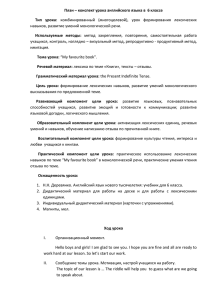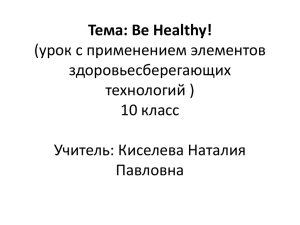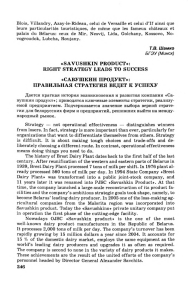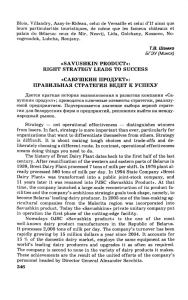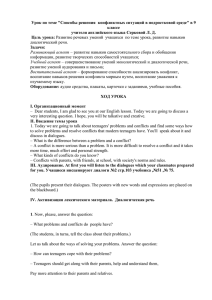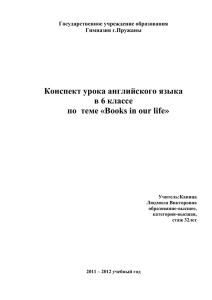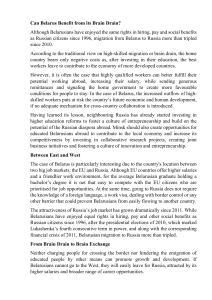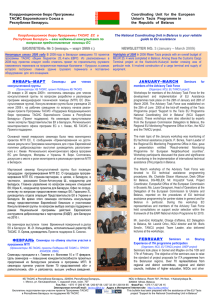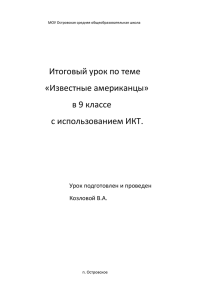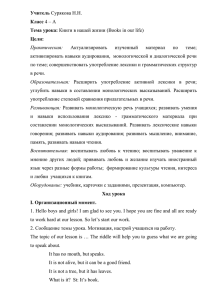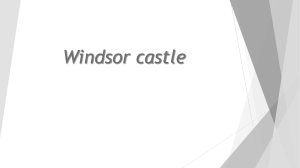План-конспект урока английского языка в 6 классе Поездка в Мир и Несвиж
реклама
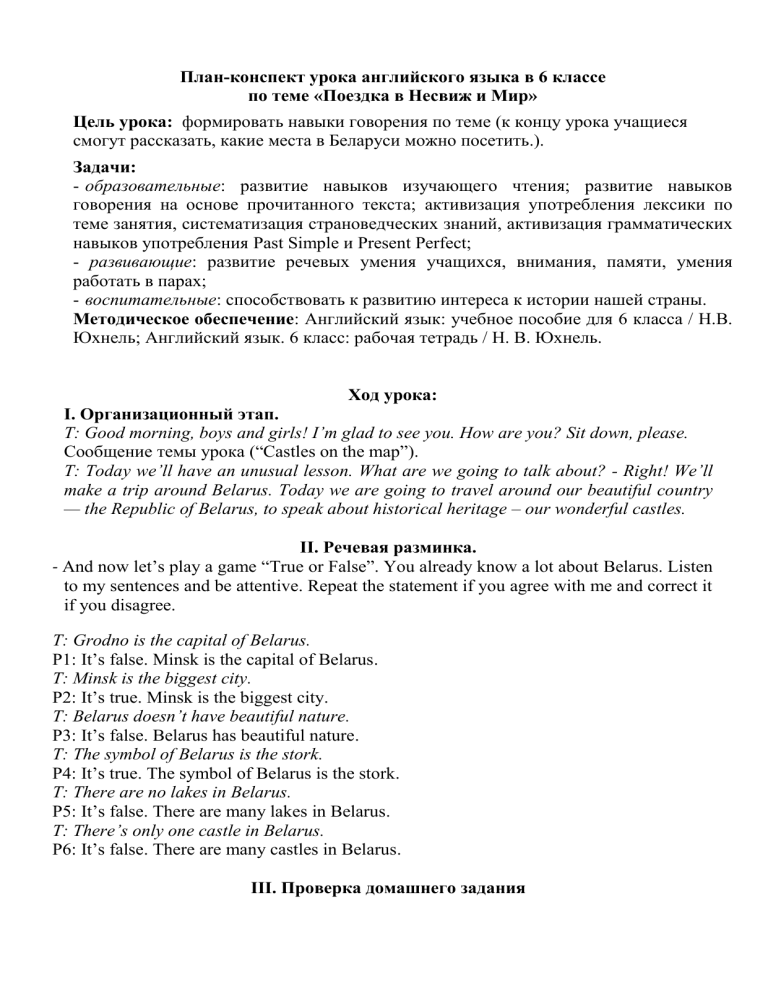
План-конспект урока английского языка в 6 классе по теме «Поездка в Несвиж и Мир» Цель урока: формировать навыки говорения по теме (к концу урока учащиеся смогут рассказать, какие места в Беларуси можно посетить.). Задачи: --образовательные: развитие навыков изучающего чтения; развитие навыков говорения на основе прочитанного текста; активизация употребления лексики по теме занятия, систематизация страноведческих знаний, активизация грамматических навыков употребления Past Simple и Present Perfect; - развивающие: развитие речевых умения учащихся, внимания, памяти, умения работать в парах; --воспитательные: способствовать к развитию интереса к истории нашей страны. Методическое обеспечение: Английский язык: учебное пособие для 6 класса / Н.В. Юхнель; Английский язык. 6 класс: рабочая тетрадь / Н. В. Юхнель. Ход урока: I. Организационный этап. T: Good morning, boys and girls! I’m glad to see you. How are you? Sit down, please. Сообщение темы урока (“Castles on the map”). T: Today we’ll have an unusual lesson. What are we going to talk about? - Right! We’ll make a trip around Belarus. Today we are going to travel around our beautiful country — the Republic of Belarus, to speak about historical heritage – our wonderful castles. II. Речевая разминка. - And now let’s play a game “True or False”. You already know a lot about Belarus. Listen to my sentences and be attentive. Repeat the statement if you agree with me and correct it if you disagree. T: Grodno is the capital of Belarus. P1: It’s false. Minsk is the capital of Belarus. T: Minsk is the biggest city. P2: It’s true. Minsk is the biggest city. T: Belarus doesn’t have beautiful nature. P3: It’s false. Belarus has beautiful nature. T: The symbol of Belarus is the stork. P4: It’s true. The symbol of Belarus is the stork. T: There are no lakes in Belarus. P5: It’s false. There are many lakes in Belarus. T: There’s only one castle in Belarus. P6: It’s false. There are many castles in Belarus. III. Проверка домашнего задания Ex. 3 p. 58. You had to complete the article with either Present Simple or Present Perfect. Let’s check it. (Уч-ся зачитывают предложения, в которых нужно было раскрыть скобки). III. Активизация грамматического материала - Usually tourists talk to each other during their journeys, don’t they? We may hear some facts from other people’s lives. For example: Mary went to London last summer. — John has never been to London. It’s always been his dream to go there. - Your task is to read the sentence in the Simple Past tense and give the clue using the sentences in the Present Perfect tense. • I visited Vitebsk last July. • I travelled to Africa in September. • I was at the circus last Friday. • I saw an elephant at the Zoo yesterday. • I was at the Opera and Ballet theatre at the weekend. • I read a book about wildlife in Australia last week. • I went to an international camp in summer. • I talked with an Englishman yesterday. • I visited the Art Museum yesterday. • I played golf when I was in Scotland. • I listened to the bagpipes in Edinburgh. • I went to the capital of Russia last spring. • I travelled to the seaside by plane. IV. Основной этап. Развитие навыков аудирования - Look at the board. What do the letters N and M mean? (Nesvizh and Mir). - What do you know about these towns? (Nesvizh and Mir castles are situated there). - What do you know about these places? Do you want to learn know more? Listen to a legend. On the way to Nesvizh people can see two trees. The birch and the oak grow together. There is a beautiful but sad legend about these trees. It happened many years ago. The daughter of Radziwil fell in love with a poor young man. The boy and the girl liked nature very much and spent a lot of time together. The girl told her father about her love. She wanted to become that young man's wife. Radziwil didn't agree. He didn't want his daughter to be poor. The girl cried, and cried, and cried. But it didn't help. Then the boy and the girl thought of a plan. And one dark night they decided to run away. When Radziwil learnt about it, he got angry. He went after his daughter. He killed them both. Later two trees grew on that place, 6 km from Nesvizh. When the wind blows, the leaves of the trees tell this sad story of their love. If you keep your ears and hearts open, you also can hear it. - Do you like this love story? Is it happy or unhappy story? Who fell in love? Did they want to get married? Did Radziwil agree? What did his daughter do? What happened next? What can we see on that place now? V. Физкультминутка T: I see that you are tired. Will you stand up? Let’s remember our poem about Nesvizh and do exercises. (Учащиеся и учитель вместе рассказывают стихотворение и выполняют упражнения.) Up, down, up, down, (Руки вверх, вниз) Where? Where? (Смотрим по сторонам) Which is the way (Разводим руками) Up in the air, (Руки вверх) To Nesvizh town? (Пожимаем плечами) Close your eyes – (Закрываем глаза) And you are there! (Открываем глаза) VI. Основной этап Работа с текстом. - Look at the board and read the words: Black Nun [ Nesvizh Residence [ ], road sign [ ], a castle [ ], ]. Ex. 3a p. 80. Look through the text and match its parts to the pictures. Ex. 3b p. 80. Read the text and choose the title for each part of the text. KEY: A – 2 The country of castles, B – 3 The Residence of Radziwils, C – 4 The red brick castle, D – The ghosts of the castle. Ex. 3c p. 81. A blue square in each paragraph marks the places where a sentence was taken out from. Put the sentences back into the paragraph. KEY:1 – B, 2 – C, 3 – A, 4 – D. *Complete the sentences (на доске, если есть время). 1. In old times people called Belarus the country of … 2. From the 16thcentury Nesvizh Castle was the residence of a rich family … 3. Since 1992 the castle in Mir has been a … 4. The castles are famous for their … Ex. 4 p. 81. Answer the questions (in pairs). 1. Have you ever been to Mir or Nesvizh? 2. When did you go there? 3. What did you see there? 4. Did you like the trip? Why? 5. If you haven’t been to Mir or Nesvizh, would you like to go there? VII. Домашнее задание Open your record-books and write down your hometask: ex. 1 p. 59 (WB). Respond to the news. Ask for details. VII. Подведение итогов - To sum up our lesson let’s think of three good reasons for visiting Mir and three good reasons for visiting Nesvizh (Reasons for visiting Mir: it's an old castle, there's no other castle like this in the world, it has a museum and a park. Reasons for vising Nesvizh are: to see the monument of Radziwil-sirotka, to meet a ghost). - You worked hard today. Your marks for the lesson are … The lesson is over. Good-bye.
